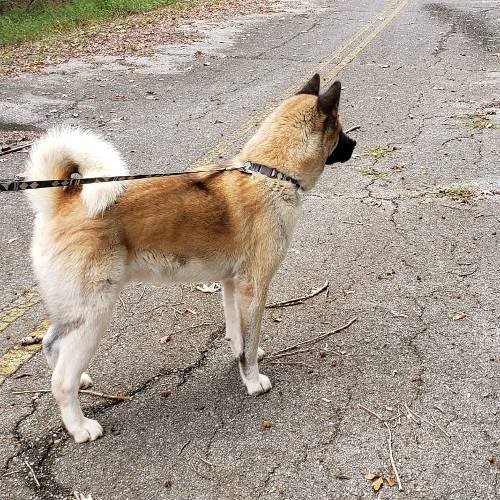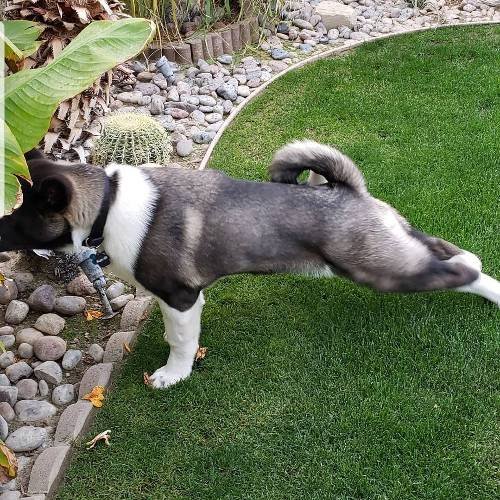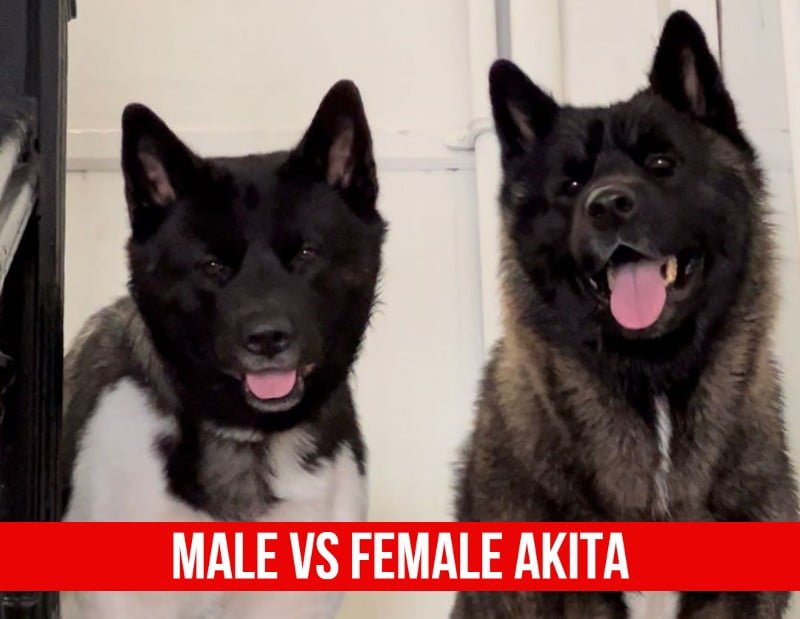There is no question that Akitas are one of the most popular dog breeds in America. And with good reason – they’re loyal, protective, and make great family pets. But when it comes to male vs female Akitas, there are some key differences you need to know. So if you’re considering adding an Akita to your family, read on for all the info you need to make the right choice
Atika’s are also known as “The Gentle Giants of the Dog World” and they have been used by Japanese families since the early 1900s. There is no doubt that an Akita is a unique breed of dog and this is the reason that it has become such a popular companion for people all over the world
However, not many people know that there are two different types of Akita’s – male and female. There are several things to consider when deciding whether a male or female Akita is right for you, such as size, energy level, and dominance. If you are thinking of getting an Akita, you should understand these differences. In this article, we will explore the differences between the two with a complete guide.
Why Are People So Interested In The Difference Among Male And Female Akitas?
- Akitas are a popular breed of dog, and many people want to know everything they can about them before they decide whether or not to get one.
- Another reason could be that they already have an Akita and are curious about the behavioral of each gender.
- Some people simply find the differences between male and female Akitas interesting from a purely academic standpoint.
- They are relatively rare dogs, so any information on them is likely to be of interest to potential owners.
- Akitas are sometimes considered to be aggressive dogs, so knowing both genders might help choose a pet that is ideal for your family.
Whatever the reason, there is no doubt that the topic of gender differences in Akitas generates a lot of interest.
10 Differences Between Male And Female Akitas
1. Male Vs. Female Akita: Differences in Appearance
Akitas are a large and strongly built breed of dog, with males typically being larger than females. The head is large and round, with a strong muzzle, and the breed has a thick double coat that is typically white, brindle, or fawn in color.
Males tend to have a “blocky” head, while females tend to have a elegant, “fox-like” face. The coats of males are usually thicker and lush, while females’ coats are typically shorter and not as dense.
Males usually have thicker necks and chests compared to females, and their legs tend to be heavier and muscular. Females are often lighter overall, with slender legs and graceful build.
2. Male Vs. Female Akita: Size Difference
Males Akitas are typically about 25% larger than females. This size difference is most apparent in the height and weight of the dog, with males often being taller and heavier than females. The head size of males is also usually larger than that of females.
Males Akitas typically weigh between 100-130 pounds, while females usually weigh between 70-100 pounds. The height of males is usually between 26-28 inches, while females are typically 24-26 inches tall.
The size difference between male and female Akitas can be attributed to the fact that males are generally considered to be the “working” dogs, while females are typically bred for show or as companion animals. Males are usually larger and muscular than females, which makes them a better fit for working roles such as guarding or hunting. Females, on the other hand, are typically smaller and delicate, making them better suited for life as companion animals.
Despite the size difference, both sexes are not necessarily athletically different. Both sexes are capable of performing the same tasks and participating in the same activities.
3. Male Vs. Female Akita: Differences in Temperament
Akita dogs are considered to be one of the popular dog breeds in Japan. The Akita breed is also well-known for its distinctively large size and robust build. But what about the differences in temperament between each gender?
When it comes to temperament, there are a few notable differences between male and female Akitas. For one, male Akitas tend to be much dominant and aggressive than their female counterparts. They also have a greater likelihood of marking their territory with urine, which can sometimes lead to conflict with other dogs.
Female Akitas are typically more gentle and loving. They are also less likely to mark their territory, making them better suited for families with small children.
4. Male Vs. Female Akita: Grooming Needs
Just like any other dog breed, Maintaining the health and cleanliness of an Akita requires regular grooming. However, there are some key differences between the grooming needs of male and female Akitas that you should be aware of.
For starters, male Akitas tend to shed more than females. This means that they will require frequent brushing to keep their coat looking clean and healthy. Male Akitas also tend to have extra pronounced facial features, such as a larger muzzle and heavier brows. This can make them susceptible to dirt and debris buildup around the face, so regular cleaning is a must.
Female Akitas, on the other hand, typically have a softer and finer coat. This means that they don’t shed as much and don’t require as much brushing. However, because their coat is finer, it can be more prone to tangles and mats. As such, regular combing and detangling are necessary to keep their coat looking its best.
Overall, both male and female Akitas require regular grooming to stay healthy and look their best. However, there are some key differences that you should be aware of to properly care for your dog. If you have any questions about the best way to groom your Akita, be sure to consult with a professional groomer or your veterinarian.
5. Male Vs. Female Akita: Energy Levels
Males generally have high energy and are more active than females. Females tend to be more calm and relaxed, and they may not be as interested in playing and running around as males are. This doesn’t mean that females can’t be active, but they usually don’t have the same high energy level as males do.
The reason male akitas have high energy levels is that they want to mate and show dominance. Akita males are larger and have bigger muscles than females so they require more energy.
The difference in energy levels between two gender can be seen in their behavior. Males are very likely to be playful and active, while females are more likely to be calm and relaxed. This difference is due to the different hormones that males and females produce. Male atikas produce more testosterone, which is a hormone that increases energy levels and activity. Female atikas produce more estrogen, which has a calming effect and lowers energy levels.
While there is a difference in the energy levels of male and female Akitas, both genders can make great pets. It’s important to choose an Akita that fits your lifestyle and activity level. If you’re looking for a high-energy dog, a male Akita is likely a good choice. If you prefer a more low-key pet, a female Akita may be a better option. Whichever gender you choose, be prepared to provide plenty of exercise and stimulation to keep your Akita happy and healthy.
6. Male Vs. Female Akita: Exercise Needs

When it comes to the exercise needs of male and female Akitas, there is no significant difference. Both sexes need a moderate amount of exercise, although males may be slightly more active than females.
In general, a daily walk is sufficient for both sexes, but they will also enjoy playing fetch or going for a run. Akitas are relatively active indoors and will do well with a large yard to explore.
Male Akita should walk an average of 30 minutes per day, while for female Akitas 20 minutes per day is enough.
7. Male Vs. Female Akita: Training Needs

Keeping your Akita trained requires a few key considerations. First, this is a very intelligent breed that can be easy to train if you are consistent and use positive reinforcement methods.
Secondly, they have a lot of energy and need plenty of exercise, both mental and physical, to stay happy and healthy.
Lastly, Akitas are very loyal and will bond closely with their family, so it is important to socialize them early and often to prevent any potential aggression issues.
Male and female Akitas generally have the same training needs. However, there are a few things to keep in mind when training each gender. Male Akitas tend to be more independent and stubborn, so it is important to be extra consistent with training. Female Akitas are often more willing to please and easier to train, but they can also be more prone to separation anxiety.
Overall, the best way to train your Akita is through positive reinforcement methods such as treats, praise, and play. Be consistent with your commands and always provide plenty of exercises and mental stimulation. With proper training, your Akita will be a loyal and loving companion for life.
8. Male Vs. Female Akita: Nutritional Needs

Besides the obvious difference in size, there is not a whole lot of difference in the nutritional needs of male and female Akitas. Both sexes need about the same amount of protein and fat, though females may need slightly less fat than males. In terms of vitamins and minerals, there are no significant differences between the sexes. However, because they are generally larger than females, Calcium, in particular, may be needed by men in greater quantities.
When it comes to feeding your Akita, the best thing to do is to consult with a veterinarian or animal nutritionist to create a diet that meets your individual dog’s needs. Akitas are generally healthy dogs, but like all breeds, they are susceptible to certain health conditions. Your Akita’s health can be affected by poor nutrition, so make sure he or she gets all the nutrients it needs.
In nutritional needs, it is prioritized that males may need slightly more of some nutrients, such as calcium. Add food ingredients such as meat, vegetables, and fruits to their daily meals. Females need the same amount of fat as males but a little less. It is better to have three main meals per day and two snacks in between for them.
The amount of food an Akita needs will vary depending on his or her age, activity level, and weight. A good rule of thumb is to feed your Akita about 2 to 3 cups of food per day, divided into two or three meals. However, it’s always best to consult with a veterinarian or animal nutritionist to determine how much food your dog needs.
Akitas are generally active dogs, so they may need more food than some other breeds. If your Akita is particularly active, you may need to increase his or her food intake. Conversely, if your Akita is relatively inactive, you may need to decrease his or her food intake.
9. Male Vs. Female Akita: Which is better for families?
When it comes to choosing an Akita, one of the most common questions is whether it is better to get a male or female. There is no easy answer to this question as each dog has its unique personality. However, some general differences between males and females may help you make your decision.
Generally speaking, male Akitas are more independent than males. This means that they are less likely to form close bonds with their owners and may be more aloof. They also tend to have an increasing sense of territoriality and maybe more Other dogs find him aggressive.
Female Akitas are more affectionate and bonded to their owners. They are also usually less Intolerant of other dogs.
10. Male Vs. Female Akita: Which is better for protection?
The Akita is a large, loyal, and alert dog breed that hails from Japan. They are known for their fearless nature and impressive size, which makes them excellent guard dogs. But when it comes to choosing between a male or female Akita for protection, which is the better option?
There are pros and cons to both sexes, so it depends on your specific needs and preferences. Male Akitas are typically more protective and territorial, which can make them better at deterring intruders or strangers. They are also usually larger, which can be a deterrent in itself. However, males can also be more aggressive and less predictable, which may not be ideal if you have small children or other pets in the home.
In comparison to their male counterparts, female Akitas are gentler, more nurturing and less aggressive than males. This can make them better suited for homes with children or other pets. However, females are usually smaller in size, which may not be ideal if you’re looking for a big, intimidating guard dog.
Ultimately, the best Akita for protection is the one that fits your specific needs and lifestyle the best. If you want a large, loyal and fearless dog that will deter intruders, a male Akita may be the best option. But if you’re looking for a more gentle and nurturing companion that will get along well with other family members, a female Akita may be the better choice.
How to tell the difference between a male and female Akita?
Akita males and females can be distinguished in several ways.
- The first clue is in their size. Males are bigger and taller.
- The second clue is in their voice. Males tend to have heavier voice tone.
- The third clue is in their hair. Males tend to have shorter hair, while females tend to have longer hair.
- The other way is to look at the dog’s chest. Male Akitas generally have a wider chest than females.
- Another clue to tell the difference is by looking at the dog’s head. Male Akitas usually have a larger head than females.
- You can also look at the dog’s behavior. Male Akitas are more active and aggressive than females.
- In addition, you can look at the dog’s coat. Male Akitas typically have a thicker coat than females.
Pros and Cons of owning a male or female Akita
There are pros and cons to owning either a male or female Akita.
Advantages of owning a male Akita:
Male Akita is a very strong and protective dog
He will watch over your family, even if you’re not around. He’s extremely loyal and fiercely protective, especially of his territory. A male Akita will defend his yard and home against intruders.
Good Companion
Akita male will be a good companion for you and your family. He’ll get along with other dogs and won’t mind being by himself.
Affectionate and loyal
Male Akitas are usually very affectionate and loyal to their owners. They’re extremely attached to their owners and they love to be cuddled.
A Male Akita will be a good watchdog
He’ll bark if he sees someone trying to break into your home, and alert you to anyone who’s in your yard. He’ll protect you and your family from intruders. Akitas are generally good guard dogs for your children.
Akitas are agility or obedience dogs.
He’s intelligent and quick, and he’ll excel at anything you train him to do. A male Akita can be a good family pet. He’ll get along with your other pets, and he’ll be gentle with your children.
Male Akitas can sometimes be left alone.
He’s an independent dog, and he won’t mind being by himself. You won’t have to worry about him getting separation anxiety or barking excessively when you’re gone.
Some Disadvantages of Owning a Male Akita
Shows Aggression
Akita males can be very dominant and aggressive towards other dogs, especially if they perceive them as a threat to their pack or territory. This can make it difficult to socialize them and integrate them into a home with other pets.
Requires a Lot of Exercise
Akita males are high energy dogs that require a lot of exercise. If they don’t get enough physical and mental stimulation, they can become bored and destructive. This means that they are not the best breed for people who live a sedentary lifestyle or who are not able to provide them with ample opportunities to run and play.
Prone to Health Problems
Like all breeds, Akitas are prone to certain health problems. Some of the most common health concerns for Akitas include hip dysplasia, elbow dysplasia, and eye problems. Akitas are also susceptible to allergies and skin infections.
Needs Firm Training
Akita males can be stubborn and strong-willed, so they need a owner who is firm, consistent, and patient. They are not the best breed for first-time dog owners.
Advantages of owning a female Akita:
Some advantages of owning a female Akita include:
Gentle and loving than males:
They tend to be more gentle and loving than their male counterparts.
Better at following commands:
Females are often better at following commands and learning tricks than males.
Not as much exercise needed:
Females do not require as much exercise as males and can be content with shorter walks or play sessions.
Live longer:
They typically live longer than most other breeds of dogs, with an average lifespan of 10-12 years.
Less Grooming Needs
They are relatively easy to groom and don’t require a lot of grooming supplies.
Some disadvantages of owning a female Akita:
Prone to digging holes
They are prone to digging holes in the yard and chewing on things they’re not supposed to chew on.
Most expensive dog breeds
Akitas are one of the most expensive dog breeds to purchase and own. They have high food and medical costs, and their grooming needs are extensive. They also require a lot of time and patience to train properly.
Don’t do well in hot weather
Akitas don’t do well in hot weather and can suffer from heat stroke if they are not properly cooled down. They are also prone to sunburn and should be kept out of direct sunlight.
More prone to health problems
Female Akitas are more prone to some health problems than males, such as pyometra and mammary tumors.
Final Thoughts
Overall, there are several significant differences between male and female Akitas. These differences can be important considerations for potential owners who are trying to choose the right dog for their families. However, it is important to remember that individual dogs of any gender can vary significantly in terms of size, temperament, and appearance.
Akita is an excellent dog choice for a family. They are fiercely loyal and will protect their family with their lives if necessary. Despite not being very easy to train, they are wonderful companions. Both genders have some drawbacks, such as their high shedding potential and their need for a special diet, but these are generally outweighed by the many positive aspects of the breed.
It is ultimately up to each potential owner to decide which gender of Akita is right for them and their family based on their specific needs and preferences.
So, here ends our list of 10 differences between male and female Akitas. Do you know any more? Let us know so we can add them to the list






